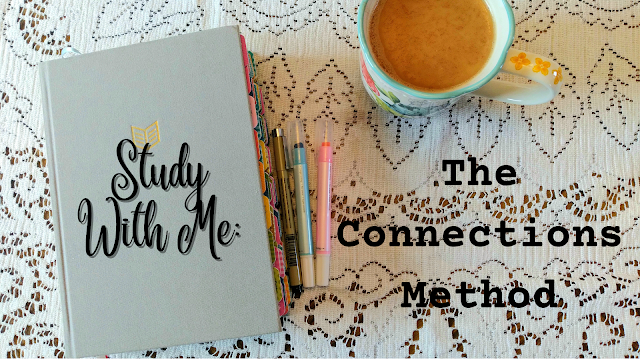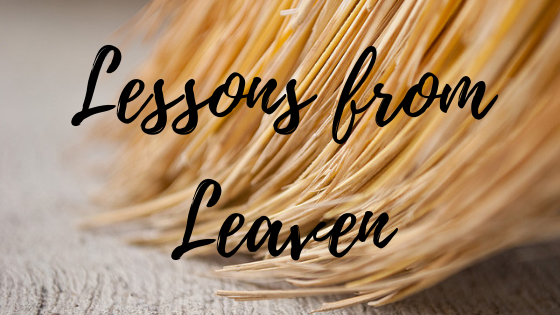Study With Me: The Connections Method
If you do an internet search for "Bible Study Methods" you will find that there are SO many to choose from! There's the Inductive Method, the Topical Method, the Devotional Method, Verse Mapping, the SOAP Method, the ACTS Method, and so on and so on. I've tried a few of these, and I've never found one that really *works* for me. I want to study the Bible in a way that I can learn what it really says and what it means in context. I don't want to rely on someone else's ideas or my own ideas to try to figure out what it means. So I've put together a method of my own, inspired by a couple of respected Bible teachers1 and by the reading and study sessions that my husband and I have together each day. I call this way of studying "The Connections Method". It doesn't rely on commentaries or devotionals, and it doesn't require drawing conclusions or trying to make every Bible passage fit directly into our modern day lives. Instead, it simply lets the Bible interpret itself and gives us room to learn what it means in context.
The Bible is written in a way that uses stories and word pictures with the same themes repeating over and over again in different ways. If we can learn to see how different passages throughout the Bible are connected with each other, then we can understand more about Yahweh, his love for us, and how he wants us to love Him and others.
The Connections Method will work for anyone from those who have just begun studying the Bible to those who have been studying for a lifetime. Using this method allows our study to go as deep as is desired and as time allows. The five basic parts to this method are:
- Pray.
- Read, and read again.
- Look for connections.
- Write them down.
- Don't forget your keys!
It sounds very simple, but it can be as involved and detailed as you make it. Here's how it works:
Step 1: Pray. Prayer and Bible study go hand in hand, and they must be done together! Prayer before, during, or after we study (or all three!) is important to keep us focused and to allow Yahweh to teach us through His written word.
Step 2: Read. Read the portion of scripture you have chosen for this study session. (The first chapter of Genesis is a good place to start.) Then read it again in one or more different translation(s). Read thoughtfully and intentionally. As you read, notice anything that stands out to you, such as:
- words and phrases
- events
- underlying themes
- situations or circumstances
Step 3: Look for Connections. Now is when the studying comes in. We are looking for connections that tie this passage to another passage in the Bible. This helps shine light on both passages and helps us see the bigger picture. We gain wisdom and understanding by comparing and contrasting different passages. The more of these connections we can make, the more we can learn.
One easy way to find some of these connections is by doing a word study. Choose one of the things in your passage that stood out to you while you were reading. Find the word in an Interlinear Bible (there's one on Biblehub.com), see what it is in the original language, what it means, and in what other passages it is used. Look up and read the other passages. You've made some connections!
Another way we can find some connections is through literary devices. Often the Bible gives us connections that are built-in to the same passage this way. Some common ones that are used in scripture are:
- The simile. A simile is a comparison of two items using a connecting word such as "like" or "as". An example of a simile in scripture is in Proverbs 4:18. "The path of the righteous is like the light of dawn, shining brighter and brighter until midday." That's a connection right there! Now we know what the path of the righteous is like, and we can look up those words if we want to get an even better picture. Reading on to verse 19 gives us another simile. "But the way of the wicked is like the darkest gloom; they don't know what makes them stumble." This tells us what the way of the wicked is like and it also contrasts it with the path of the righteous in the previous verse.
- The metaphor. A metaphor is similar to a simile, but is a direct comparison of two items (X=Y). Here's a good example in Isaiah 64:8: "Yet LORD, you are our Father; we are the clay, and you are our potter; we all are the work of your hands." So the LORD (Yahweh) = our Father = our potter, and we = the clay = the work of his hands. This gives us several connections within one verse!
- Parallelisms. A parallelism is when something is stated and then immediately stated again in a different way. In this way scripture defines itself! For instance, Psalm 19 begins with four of them: Verse 1 says, "The heavens declare the glory of God, and the expanse proclaims the work of his hands." See how the first part is re-stated in a different way in the second part? The heavens = the expanse, and the glory of God = the work of his hands. If we read on, we'll see three more. "Day after day they pour out speech; night after night they communicate knowledge. There is no speech; there are no words; their voice is not heard. Their message has gone out to the whole earth, and their words to the ends of the world." Recognizing parallelisms is a great way to make some instant connections. Once you have noticed a parallelism, you can do word studies to increase your understanding even more.
- Chiastic Structure. Chiastic structure, or a chiasm, is a little bit difficult to explain, so let me show you. Here's a photo of a note from my Bible from Hosea that shows a chiasm:See how A and A1 correspond to each other, just as B and B1 and C and C1 do? Then D in the middle is the central idea that the whole chiastic structure is pointing toward. This is the idea the chiasm is trying to emphasize and get across to the reader. This is another example of one of those connections we want to make! The Bible is full of these chiasms, and they help our understanding when we can learn to see them.
- The Appointed Times (you might know these as the Biblical Holidays and the Sabbath).
- Agriculture.
- The Calendars.
- The Temple.
- Connections can more easily be made if you are reading regularly from two different parts of scripture. For instance, you could begin reading in Genesis 1 and in Matthew 1 and read a chapter of each every time you read. Let the connections begin!
- Chapters and verses are only useful for keeping track of where we are reading and looking things up. Otherwise, please ignore them. They were not there originally.
- Section headings were definitely not there originally. Please also ignore them. They can tend to make us already biased in our thinking as we begin to read a section.
- When you begin a reading and study session, be sure to go back and read the end of where you left off. This will get you started with some context.
- When studying the Bible we are looking for quality, not necessarily quantity. Sometimes it's necessary to take things a little slower. Don't feel obligated to read a certain amount every day. If you are reading consistently and conscientiously then you are doing great.
1 This method is inspired by Tony Robinson's Thematic Analysis (Restoration of Torah Ministries), and Joseph Good's series, "The Lost Key" (Jerusalem Temple Study).




Comments
Post a Comment